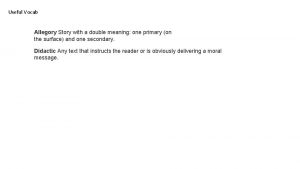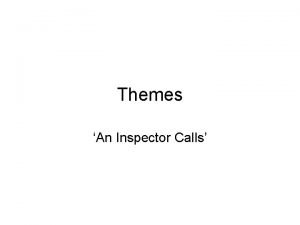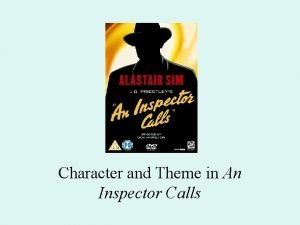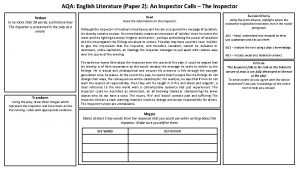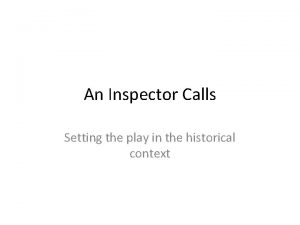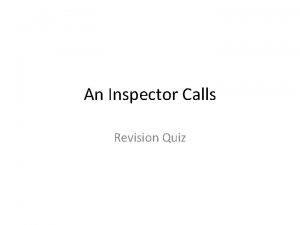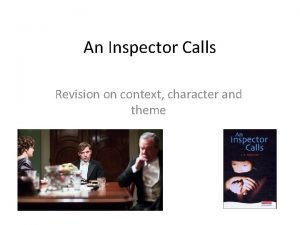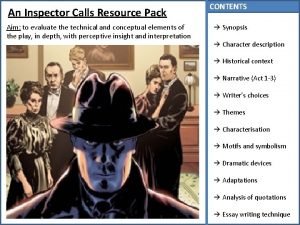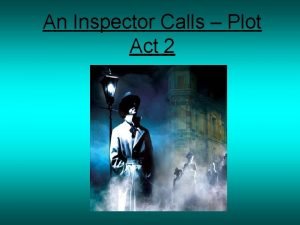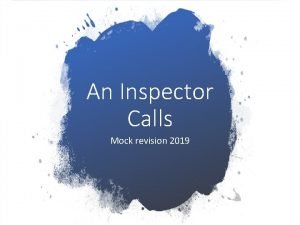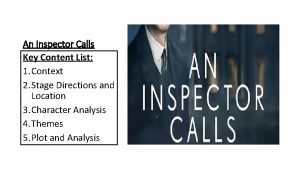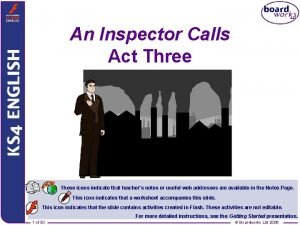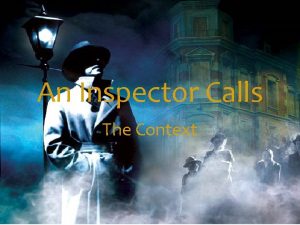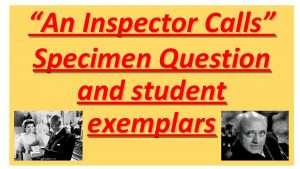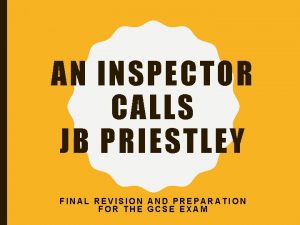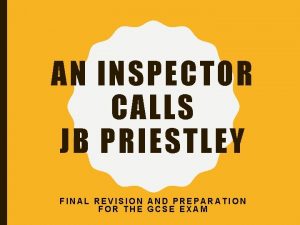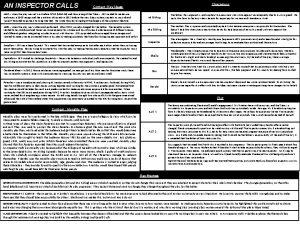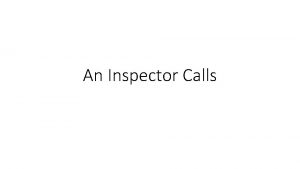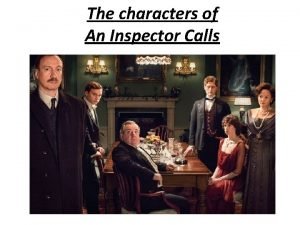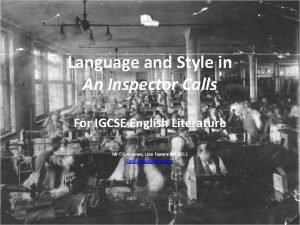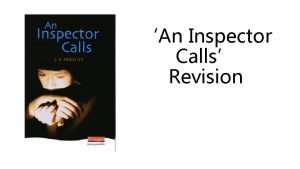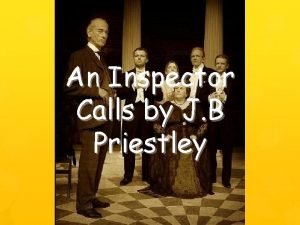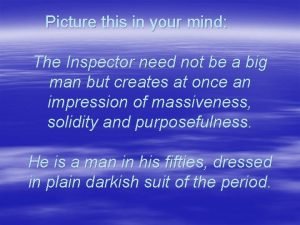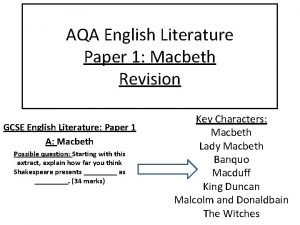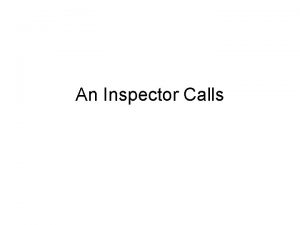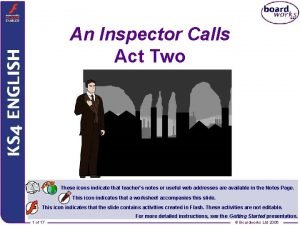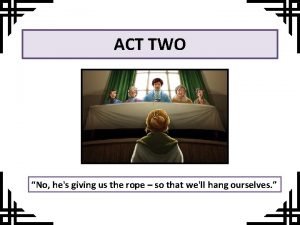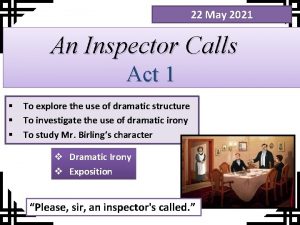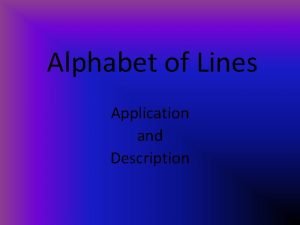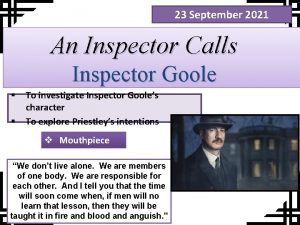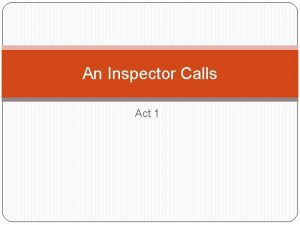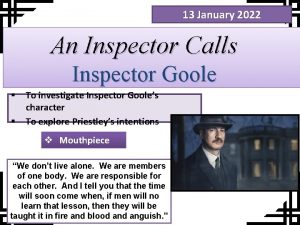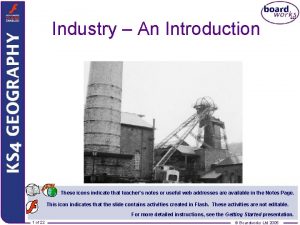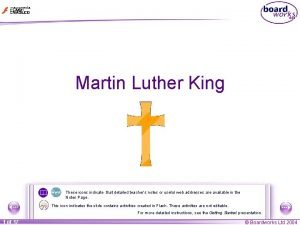An Inspector Calls Introduction These icons indicate that

































- Slides: 33

An Inspector Calls Introduction These icons indicate that teacher’s notes or useful web addresses are available in the Notes Page. This icon indicates that a worksheet accompanies this slide. This icon indicates that the slide contains activities created in Flash. These activities are not editable. For more detailed instructions, see the Getting Started presentation. 1 of 33 © Boardworks Ltd 2006

Unit introduction In this unit we will be studying the play An Inspector Calls by J B Priestley. The play is performed in three acts, and for each act you will be completing a variety of activities to develop your understanding of the text. Before we start reading the play, it will be useful to find out about the author and the social, historical, theatrical and political contexts in which the play was written. 2 of 33 © Boardworks Ltd 2006

Author information 3 of 33 © Boardworks Ltd 2006

Priestley’s political viewpoint Much of Priestley’s writing was controversial and many of his plays and novels have strong political messages. During the 1930 s, Priestley became increasingly aware of the social inequality of life in Britain. Priestley helped to develop the idea of the Welfare State which the Labour Party established in the years following World War II. Priestley’s audiences in 1946 had just lived through World War II, and were faced with a time of great change and opportunity. Priestley wanted people to take the opportunities for progress available to them. He encouraged his audiences to judge the middle-class social values of 1912 in the light of the morality of 1945. 4 of 33 © Boardworks Ltd 2006

The theatrical context At the outbreak of World War II in 1939, theatres were competing for audiences with the new ‘talking pictures’ available in the cinemas. The most popular form of theatre was the musical – big, lavish, glamorous productions. Farces (comedies) and detective thrillers, by writers such as Agatha Christie, were also popular. When war came many theatres closed down or moved from London. An Inspector Calls was first seen on stage in London on 1 October 1946, performed by the Old Vic Company. 5 of 33 © Boardworks Ltd 2006

The historical context 6 of 33 © Boardworks Ltd 2006

Areas for study 7 of 33 © Boardworks Ltd 2006

An Inspector Calls Act One These icons indicate that teacher’s notes or useful web addresses are available in the Notes Page. This icon indicates that a worksheet accompanies this slide. This icon indicates that the slide contains activities created in Flash. These activities are not editable. For more detailed instructions, see the Getting Started presentation. 8 of 29 33 © Boardworks Ltd 2005 2006

Set design It is very important, as you are reading, to remember that An Inspector Calls is a play and was written to be performed. Priestley not only wrote the words for the actors to speak – the dialogue – but also provided stage directions to explain what the set and the characters should look like. Using the stage directions at the beginning of Act One, design your own set for the opening of the play. 9 of 33 © Boardworks Ltd 2006

Set design 10 of 33 © Boardworks Ltd 2006

Set design – Stephen Daldry’s production One of the most famous productions of this play was directed by Stephen Daldry. Read the following extract of a review of the play which describes the stage set. “Daldry's production opens before the curtain is up with an old red telephone box at an angle … the floorboards curled up after an explosion. A young boy in short trousers helps raise the curtain to reveal a substantial Edwardian house perched about the detritus of a bomb site … The Edwardian house opens only after the characters have looked out from the windows. The people are oversize in relation to the house … and in the distance we can see a model house and lamp post, tiny replicas as if distancing us spatially, a physical manifestation of the decades separating us from the action. The house swings open to reveal a dining room but the characters emerge to be interviewed by the detective who stands enigmatically under the lamp post in his mackintosh and fedora. ” 11 of 33 © Boardworks Ltd 2006

Set design – Stephen Daldry’s production How does your set design differ from Daldry’s production? Why do you think he chose to set it this way? What effect would his design have on the audience? An Inspector Calls was first staged immediately after World War II. Daldry’s set interweaves the 1945 time period into the Edwardian set described by Priestley, to include echoes of England after the Blitz bombing. The set reflects both periods. This reminds us that we are judging the middle-class social values of 1912 in the light of the post-war morality of 1945. 12 of 33 © Boardworks Ltd 2006

Characters 13 of 33 © Boardworks Ltd 2006

Plot summary exercise – Act One 14 of 33 © Boardworks Ltd 2006

Social status At the beginning of the play the Birling family is celebrating the engagement of their daughter Sheila to Gerald Croft. Gerald’s parents are not there. Is there any significance to this? If so, what do you think it is? It’s a pity Sir George and – er – Lady Croft can’t be with us but they’re abroad and so it can’t be helped. 15 of 33 © Boardworks Ltd 2006

Social status We are told in the opening stage directions that Mr Birling is ‘rather provincial in his speech’ and that Mrs Birling is ‘her husband’s social superior’. Gerald’s parents are Sir George and Lady Croft and therefore from a higher position in society than the Birlings. Croft’s business is an older and bigger company so they are also more wealthy than the Birlings. When the men are alone together, Mr Birling states that he believes Lady Croft feels Gerald might have ‘done better for himself socially’ by marrying someone other than Sheila. He tells Gerald he expects to be getting a knighthood which would improve his social standing. 16 of 33 © Boardworks Ltd 2006

Dramatic irony is the technique where a writer allows the audience to know more than a character in the novel or play. There is then a contrast between the character's limited understanding of his or her situation and what the audience knows. Priestley uses dramatic irony throughout the play. Can you find any examples of dramatic irony in the first act of An Inspector Calls? 17 of 33 © Boardworks Ltd 2006

Dramatic irony Priestley first uses dramatic irony in relation to Mr Birling in the first act. Look again at Mr Birling’s speeches which begin: ‘Glad you mentioned it, Eric’ and finish: ‘And we don’t guess – we’ve had experience – and we know’. What does Mr Birling talk about which we, the audience, know more about than he does? What effect does Priestley’s use of dramatic irony have on the audience? 18 of 33 © Boardworks Ltd 2006

Dramatic irony Priestley’s use of dramatic irony affects our opinion of Mr Birling. We know that Mr Birling thinks highly of himself but we realize that in fact he is not right about several things. This helps us to understand that many of his other attitudes and opinions may be wrong too. …you’ll hear some people say that war’s inevitable. And to that I say – fiddlesticks! …the Titanic – she sails next week … New York in five days – and every luxury – and unsinkable, absolutely unsinkable. 19 of 33 © Boardworks Ltd 2006

Dramatic irony Topic Labour relations War The Titanic G B Shaw &HG Wells 20 of 33 What Mr Birling What we know happened says will happen All sorted out. General Strike in 1926 No problem with workers World War I There will be no war 1914 -1918 Absolutely unsinkable Sank 14 April 1912 No one should listen to them – they are idealists They were influential in improving Britain’s treatment of the poor © Boardworks Ltd 2006

The inspector arrives 21 of 33 © Boardworks Ltd 2006

The inspector arrives Do you think the name Priestley gives his inspector is significant? Some commentators have suggested that Priestley chose to call his inspector ‘Goole’ as a pun. A play on words – using a word because it sounds the same as another although it has a different meaning. What other meaning of a word sounding like ‘Goole’ is there that Priestley might have been thinking of? A ghoul is an evil demon (supernatural being) or someone obsessed by another’s death. 22 of 33 © Boardworks Ltd 2006

Inspector Goole Is Inspector Goole ghoulish? How much do we learn about the inspector? Fill in the table with quotes that support your ideas. What do we learn? Evidence New to the area ‘only recently transferred’ 23 of 33 © Boardworks Ltd 2006

Eva Smith The first we hear of Eva Smith is the inspector’s description of her death. Two hours ago a young woman died in the Infirmary. She’d been taken there this afternoon because she’d swallowed a lot of strong disinfectant. Burnt her inside out, of course. Like a lot of these young women who get into various kinds of trouble, she’d used more than one name. But her original name – her real name – was Eva Smith. What do you think the inspector means by ‘a lot of these young women who get into various kinds of trouble’? 24 of 33 © Boardworks Ltd 2006

Mr Birling is the first to be questioned by Inspector Goole. How does he react to the inspector’s questions? What do we learn about his involvement in Eva Smith’s death? Why do you think the inspector only shows the photograph to Mr Birling? 25 of 33 © Boardworks Ltd 2006

Mr Birling refuses to accept any responsibility for Eva’s death. If we were all responsible for everything that happened to everybody we’d had anything to do with, it would be very awkward, wouldn’t it? Do you agree with Mr Birling? Do you think Mr Birling was justified in firing Eva Smith? Eric states that he would ‘have let her stay’. What would you have done? 26 of 33 © Boardworks Ltd 2006

Mr Birling Build up a character profile of Mr Birling using the table below. Find quotes and examples to support your ideas. Personality 27 of 33 Evidence © Boardworks Ltd 2006

Sheila Birling Look at Sheila’s entrance. How does the mood of the scene change? Brainstorm what you know about Sheila at this stage of the play. In a good mood Has just got engaged Interested in clothes 28 of 33 © Boardworks Ltd 2006

Sheila Birling How does Sheila react to the news of Eva’s death and her father’s involvement? …these girls aren’t cheap labour – they’re people. What do we learn about Sheila’s involvement in Eva Smith’s death? Does Sheila accept responsibility for Eva’s death? Do you think she is responsible? 29 of 33 © Boardworks Ltd 2006

Character reactions 30 of 33 © Boardworks Ltd 2006

Gerald Croft Gerald gives away his acquaintance with Eva Smith when he utters a startled ‘What? ’ in response to the news that ‘she changed her name to Daisy Renton’. What do we learn about Gerald’s involvement with Daisy Renton? 31 of 33 © Boardworks Ltd 2006

Characters 32 of 33 © Boardworks Ltd 2006

Act One questions Has your opinion of any of the characters changed during Act One? How has the mood changed during Act One? Is there anything unusual about the inspector? At the end of the act Sheila states ‘he knows. Of course he knows. ’ How much do you think the inspector already did know? Can you predict what will happen next? How do you think the play will end? Mr Birling says ‘In twenty or thirty years’ time – let’s say, in 1940 – you may be giving a little party like this … and I tell you, by that time you’ll be living in a world that’ll have forgotten all these Capital versus Labour agitations and all these silly little war scares…’ How do you think the 1940 s audience would have reacted to this statement? What about an audience today? 33 of 33 © Boardworks Ltd 2006
 Double meaning story
Double meaning story Themes in an inspector calls
Themes in an inspector calls Arthur birling character profile
Arthur birling character profile Aqa english literature paper 1 inspector calls
Aqa english literature paper 1 inspector calls 1912 strikes an inspector calls
1912 strikes an inspector calls Match each character with his perspective
Match each character with his perspective Look mummy isn't it a beauty analysis
Look mummy isn't it a beauty analysis Socialism and capitalism in an inspector calls bbc bitesize
Socialism and capitalism in an inspector calls bbc bitesize An inspector calls act 2
An inspector calls act 2 An inspector calls recall questions
An inspector calls recall questions Theme in inspector calls
Theme in inspector calls An inspector calls plot
An inspector calls plot Inspector calls wordsearch
Inspector calls wordsearch An inspector calls starter activities
An inspector calls starter activities An inspector calls questions
An inspector calls questions Kahoot an inspector calls
Kahoot an inspector calls Rose tinted glasses an inspector calls
Rose tinted glasses an inspector calls Generation gap in an inspector calls
Generation gap in an inspector calls Context of an inspector calls
Context of an inspector calls An inspector calls act 1 questions
An inspector calls act 1 questions What does steady the buffs mean in an inspector calls
What does steady the buffs mean in an inspector calls An inspector calls stage
An inspector calls stage Sheila birling character profile
Sheila birling character profile Edexcel inspector calls exam questions
Edexcel inspector calls exam questions An inspector calls act 1 revision
An inspector calls act 1 revision An inspector calls opening stage directions
An inspector calls opening stage directions The inspector need not be a big man
The inspector need not be a big man How to revise for english literature gcse
How to revise for english literature gcse Insecak
Insecak An inspector calls summary act 2
An inspector calls summary act 2 An inspector calls he's giving us the rope
An inspector calls he's giving us the rope An inspector calls act 1 questions
An inspector calls act 1 questions An inspector calls responsibility essay
An inspector calls responsibility essay Visible lines
Visible lines
